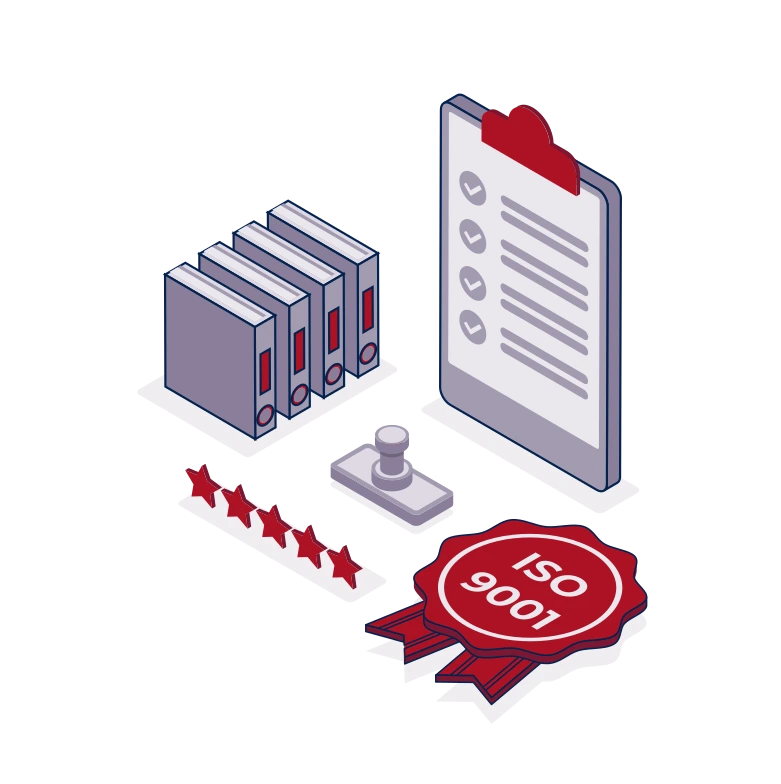Freight Shipping between Qatar and Bahrain | Rates – Transit times – Duties and Taxes
While juggling a shipping route as convoluted as a contortionist's yoga routine isn't the way to cheer your morning, understanding freight transport between Qatar and Bahrain can be a lifesaver. Grappling with the bewilderment of rates, transit times, and customs regulations often seems like a task Hercules would shy away from. Fear not! This guide will illuminate your path by shedding light on different types of freight options - whether it be by air, sea, road, or rail, diving into the intricacies of customs clearance, duties, and taxes, and making it digestible with practical advice tailored for your business. If the process still feels overwhelming, let DocShipper handle it for you! We are your international freight forwarding partner committed to turning shipping challenges into success stories for businesses across the globe.
Which are the different modes of transportation between Qatar and Bahrain?
Which are the different modes of transportation between Qatar and Bahrain? Choosing the right transport method between Qatar and Bahrain is like deciding whether to take a quick jump across the stepping stones or a leisurely paddle around the pond. With no land borders and a mere 140 km of Persian Gulf waters separating them, air and sea freight emerge as logical picks. The ultimate decision, however, mirrors a balanced dance between the cargo’s nature, your speed vs. cost preferences, and the rhythm of import-export regulations. Think of it like packing for a holiday - it all depends on what you're taking and how fast you need to get there!
Need help with your shipment?
Need assistance with your shipment? Dont hesitate to contact us even for a simple question. Choose the option that suits you
Live chat with an expert Chat on WhatsApp Free Quote 24hHow can DocShipper help you

Sea freight between Qatar and Bahrain
Ocean shipping between Qatar and Bahrain isn’t just about loading goods onto a ship and praying for fair weather. It’s a pulsating artery in the heart of Middle East’s trading network, the backbone of the vigorous industrial scene trotting from Qatar’s Mesaieed port to Bahrain’s Khalifa bin Salman port. Thriving on high-volume goods, sea freight may not top the speed charts but it retains the crown for cost-effectiveness.
That said, treading these waters isn’t always smooth sailing. Misjudgments, like one-size-fits-all strategies, can tie your trade endeavors into knots. But remember, each shipping journey calls for tailored tactics. It’s like baking a cake—you can’t swap the flour for icing sugar and expect a perfect dessert. This section canvasses through such experiences and lays out best practices to navigate through these common pitfalls, aiming for a seamless shipping voyage from port to port. So whether you’re a first-time shipper or a jaded sea dog, you’ll discover a lifeline of insights, designed to keep your business afloat.
Main shipping ports in Qatar
Hamad Port
Location and Volume: Situated in Umm Al Houl, the Hamad Port is Qatar’s main seaport, providing a vital gateway for the country. With its state-of-the-art facilities, it can handle around 7.8 million TEUs annually.
Key Trading Partners and Strategic Importance: The port has strong trading relationships with various countries globally, such as China, India, and the USA. As Qatar’s largest port, it plays an essential role in the country’s economy, encouraging commercial growth and development.
Context for Businesses: If you’re planning to expand to the Qatar market or wish to secure a reliable route for import/export, the Hamad Port makes an attractive choice. Its modern facilities ensure a high efficiency level in handling cargo, which can positively impact your logistics and supply chain strategy.
Doha Port
Location and Volume: Located in the country’s capital, Doha, this port was an essential component in Qatar’s maritime operations before the establishment of Hamad Port. Today, it mainly serves the needs of smaller traffic and touristic vessels, with a role in the upcoming FIFA World Cup 2022.
Key Trading Partners and Strategic Importance: Doha Port isn’t a significant hub for international trade, reflecting its smaller size and volume. However, it still serves local floating markets and regional trade, serving a strategic role as a hub for tourism-related activities.
Context for Businesses: Despite its smaller freight role, Doha Port might be a relevant consideration for businesses seeking opportunities in Qatar’s tourism industry or those looking for smaller scale, regional shipping needs.
Ras Laffan Port
Location and Volume: Positioned in the North Eastern corner of Qatar, Ras Laffan Port is a hub for the shipping of liquefied natural gas (LNG), with an incredible capacity to accommodate up to 266 LNG ships.
Key Trading Partners and Strategic Importance: Primarily exporting to Asian countries like India, South Korea, and Japan, the port is central to Qatar’s dominant position in the global LNG market.
Context for Businesses: For companies involved in the energy industry, particularly LNG, Ras Laffan Port offers unrivaled opportunities. Given Qatar’s substantial position in the LNG market, cooperating with operations at Ras Laffan can give businesses a competitive edge in this sector.
Considering Qatar’s port offerings, the Hamad Port is undoubtedly the standout choice for most businesses. However, both Doha Port and Ras Laffan offer unique opportunities for very specific types of businesses who would benefit from their respective strengths in tourism or energy sector operations.
Main shipping ports in Bahrain
Port of Khalifa Bin Salman
Location and Volume: Located in Hidd, the Port of Khalifa Bin Salman is the main maritime gateway for the Kingdom of Bahrain. It handles over 1 million TEU annually and is known to provide the largest breakbulk terminal with no draft restrictions.
Key Trading Partners and Strategic Importance: This port has strong business ties with China, India, UAE, Saudi Arabia and the United States. Aside from being strategically located close to the Middle East’s key economies, the Port of Khalifa bin Salman has state-of-the-art cargo handling equipment, providing efficient, speedy, and safe cargo operations.
Context for Businesses: If your business strategy involves reaching Middle Eastern, Asian, or American markets in a efficient way, the Port of Khalifa Bin Salman might be a cornerstone of your logistics operations given its superb location, modern infrastructure and reliable performance. This port offers several benefits, such as a full range of services that can accommodate oversized cargo and delicate goods, making it ideal for businesses working in various industries.
Port of Mina Salman
Location and Volume: Found in Manama, the Port of Mina Salman, a subsidiary of APM Terminals, boasts substantial cargo and passenger operations, with its logistics infrastructure handling about 330,000 TEU per year.
Key Trading Partners and Strategic Importance: Countries like the UAE, US, Saudi Arabia, India, and China rely heavily on this port for their import and export needs. Its strategic importance is accentuated by the fact that it is Bahrain’s principal port for general cargo and roll-on/roll-off operations.
Context for Businesses: If your plan is to reach diverse markets in the Middle East, Asia, or the Americas, the Port of Mina Salman can significantly aid your shipping operations. With a focus on efficiency and reliability in cargo handling, the port is equipped to handle a wide range of goods, whether they’re part of a containerized shipment, or bulk and roll-on/roll-off freight.
Should I choose FCL or LCL when shipping between Qatar and Bahrain?
Choosing between Full Container Load (FCL) and Less than Container Load (LCL) – often referred to as consolidation – can be a game-changer for your sea freight shipping between Qatar and Bahrain. This decision ties directly to cost-efficiency, timely delivery, and overall success of your shipment. Your choice will depend on numerous factors, such as the volume of your cargo and your flexibility with delivery times. In the forthcoming section, digestible insights will empower you to make an informed decision matching your unique shipping needs. So, ready to dive in and conquer the world of sea freight?
Full container load (FCL)
Definition: FCL, or Full Container Load, refers to an exclusive right to fill a sea freight container with your cargo. This popular method, known as FCL shipping, ensures you control the entire space inside either a 20'ft container or a 40'ft container.
When to Use:
Opting for FCL is particularly beneficial when dealing with cargo exceeding 13-15 cubic meters (CBM). It's not only cost-effective for high-volume shipments, but also offers added safety because your goods remain sealed from origin to destination.
Example:
For instance, if a furniture manufacturer in Qatar wishes to send a bulk shipment of chairs to Bahrain that exceeds 15 CBM, FCL would serve as the optimal choice.
Cost Implications:
Although having the entire FCL container to yourself might initially seem more expensive, remember that you're paying for a flat rate. So as your cargo volume increases, you get better value per cubic meter. Also, don't forget to factor in potential lower risk of damage with FCL. For a customized FCL shipping quote, it's recommended to consult with your freight forwarder as costs are subject to a myriad of factors such as container size, type of goods, and seasonality.
Less container load (LCL)
Definition: LCL, or Less than Container Load, is a shipping method where your cargo occupies a portion of a consolidated container.
When to Use: LCL is the optimal choice when dealing with cargo volumes less than 13, 14, or 15 CBM. Its flexible nature allows for smaller quantities to be dispatched without having to fill a whole container, making it apt for businesses with lower volume needs.
Example: Imagine you're a business owner exporting artisanal handicrafts from Qatar to Bahrain. Your monthly supply doesn't exceed 10 CBM. In this case, LCL freight serves as an ideal shipping method. It enables you to share container space with other businesses, cutting down on the investment of hiring a full container.
Cost Implications: Being a more flexible solution, LCL often works out to be cheaper for small volume shipments. With a pay-per-space-used model, you only bear the cost for the exact space your goods occupy in the container, aiding in optimized budget management. Nonetheless, it's important to consider the aspect of LCL freight charges which include costs for the handling and consolidation of your LCL shipments at the port. Proper planning and timely scheduling can further assist in keeping these costs in check.
Hassle-free shipping
Navigating international trade can be puzzling. Let DocShipper simplify it for you. As seasoned freight forwarders, our team offers bespoke services tailored to your unique business needs. With our ocean freight experts, you'll easily understand the pros and cons of consolidation or full container shipping between Qatar and Bahrain. Consider factors like shipment size, urgency, and cost-efficiency. Don't let the complexities of cargo shipping slow your business down. Reach out for a free estimation and let's streamline your operations together.
Shipping goods via sea freight from Qatar to Bahrain usually takes an average of 1-3 days. However, it’s quite crucial to keep in mind that these transit times vary based on certain factors, such as the specific sea ports used, the weight, and the very nature of the goods being transported. It is, therefore, most advisable to reach out to a reliable international freight forwarder like DocShipper for an accurate and personalized quote tailored to your unique needs.
Here below is a rough guide for the average transit times, in days, between the main freight ports in both nations:
| Port of Qatar | Port of Bahrain | Average Transit Time (Days) |
| Hamad Port | Khalifa Bin Salman Port | 1 |
| Ras Laffan Port | Khalifa Bin Salman Port | 3 |
*Please note once again that these are approximate timings and can change based on various factors. Therefore, for a specific quote, contact a seasoned freight forwarder.
How much does it cost to ship a container between Qatar and Bahrain?
Understanding the shipping cost between Qatar and Bahrain can seem complicated, especially with ocean freight rates varying widely per CBM. You see, numerous variables come into play here, such as Point of Loading, Point of Destination, the carrier employed, the type of merchandise, and the ever-changing market conditions each month. But don’t fret – crystal clear, bespoke pricing is absolutely within reach. Our dedicated shipping specialists work tirelessly to cut through these complexities and deliver you the best possible rates, tailoring each quote to your unique scenario. The world of international freight doesn’t need to be baffling – with us, it’s personal, professional, and crystal-clear.
Special transportation services
Out of Gauge (OOG) Container
Definition: An OOG container is designed to accommodate out of gauge cargo which exceeds the dimensions of standard shipping containers.
Suitable for: Large items including machinery, vehicles, or heavy equipment that cannot fit into standard containers.
Examples: Construction equipment, large pipes, wind turbine components, and heavy machinery.
Why it might be the best choice for you: If your goods can’t be disassembled and are too large for standard containers, the OOG container provides the flexibility and safety required to cater to your shipping needs.
Break Bulk
Definition: Break bulk is a shipping method where goods are loaded individually, not in containers or packaging.
Suitable for: Irregular, oversized, and uncontainerized goods.
Examples: Industrial equipment, generators, turbines, steel beams, or logs.
Why it might be the best choice for you: When your cargo cannot be containerized due to size or shape, Break Bulk is a reliable and cost-effective solution.
Dry Bulk
Definition: Dry Bulk shipping involves transportation of homogenous, loose cargo like grain, coal, or ore in large quantities.
Suitable for: Commodities that pour directly into the ship’s hold.
Examples: Agricultural products, minerals, fertilizers, ores, coal, or cement.
Why it might be the best choice for you: Opt for this method if your business deals with commodities that can be loaded freely into the vessel, and you require cost-efficient large-scale transportation.
Roll-on/Roll-off (Ro-Ro)
Definition: A Ro-Ro vessel is specifically designed to carry wheeled and tracked vehicles as all cargo.
Suitable for: Cars, trucks, trailers, semitrailers, tractors, buses, mobile cranes or any equipment on wheels.
Examples: Car manufacturers might use this method to transport hundreds of cars at once.
Why it might be the best choice for you: If speed and simplicity are key, and your freight is mobile, the Ro-Ro service provides fast loading and unloading processes.
Reefer Containers
Definition: Refrigerated containers are temperature-controlled containers used to transport temperature-sensitive goods.
Suitable for: Perishables including fruits, vegetables, dairy products, and seafood.
Examples: Wine, seafood, pharmaceuticals, or frozen goods that need a specific, stable temperature during transport.
Why it might be the best choice for you: If you deal with products that need a temperature-controlled environment to prevent spoilage, reefer containers would be your go-to solution.
No matter which option suits your needs, remember that every shipping method has its unique benefits. DocShipper offers all these services and more. Feel free to reach out to us anytime for a free shipping quote within 24 hours. You ship, we care!
Air freight between Qatar and Bahrain
Air freight from Qatar to Bahrain is like receiving a lightning-fast email – it’s speed and reliability unmatched, particularly beneficial for small, high-value items. Picture this: You’re shipping high-end watches encrusted with the most exquisite gems, prized for their beauty and worth. Air freight becomes your best buddy, ensuring these watches reach their destination secure and swift as a falcon.
However, preparing for air freight is uncharted territory for many shippers. It’s like attending an auction without knowing the true value of the items. Many stumble upon hidden pitfalls like improper weight estimation leaving them with larger bills than expected. As we venture further, we’ll unpack these common missteps and arm you with insider tips to soar high in your air freight journey.
Air Cargo vs Express Air Freight: How should I ship?
Overwhelmed by choices when shipping your goods between Qatar and Bahrain? Let’s simplify it for you. In a nutshell, air cargo means your product hops aboard a regular airline, making it a budget-friendly option that shares the space. Opting for express air freight? You’re booking a speedy, dedicated plane for your goods – a premium solution for when time is money! Dive in to discover which suits your business best.
Should I choose Air Cargo between Qatar and Bahrain?
Considering air cargo for your freight between Qatar and Bahrain? It’s a reliable option when cost-effective transportation takes precedence. Major airlines such as Qatar Airways and Gulf Air service this route, ensuring your products reach their destination in a timely manner, albeit with slightly longer transit times due to fixed schedules. Your consignments from 100/150 kg (220/330 lbs) might find air freight particularly beneficial. Check out Qatar Airways and Gulf Air for more details. Make a savvy decision for your budget and business needs!

Should I choose Express Air Freight between Qatar and Bahrain?
Experience the speed and efficiency of express air freight, ideal for lighter shipments below 1 CBM or around 100/150 kg (220/330 lbs). By employing dedicated cargo planes, services like FedEx, UPS, and DHL swiftly transport goods from Qatar to Bahrain with no passenger interference. For time-sensitive or valuable products, this route might be your best bet. Enjoy faster customs clearance and delivery straight to your door, saving precious time and streamlining your shipping process. So, if quick delivery is your goal, express air freight is your answer. Choose the industry leaders, choose express.

Main international airports in Qatar
Hamad International Airport
Cargo Volume: Hamad International Airport handled approximately 2.4 million tonnes of cargo in 2023.
Key Trading Partners: Major trade partnerships are with countries in the Asia Pacific region, the United States, and Europe.
Strategic Importance: Located in Doha, it serves as Qatar Airways’ hub and is one of the busiest cargo handling airports in the world. Its strategic geographical location connects the East and the West.
Notable Features: The airport boasts two parallel runways that are capable of handling A380 aircraft, a terminal dedicated to cargo, and state-of-the-art facilities for managing various types of freight.
For Your Business: With its vast network and advanced technology, Hamad International is one of the best options if you’re considering air freight for your business. This location is particularly beneficial for time-sensitive shipments due to its high volume handling capacity and efficient processing.
Note: Hamad International Airport is the main international cargo airport in Qatar. As such, this guide focuses solely on this airport for your business shipping needs in and out of Qatar. Other airports in the country may be available for very specific situations, but Hamad is the go-to hub for most international cargo shipments.
Main international airports in Bahrain
Bahrain International Airport
Cargo Volume: Bahrain International Airport processed 314,986 metric tons of cargo in 2023, demonstrating its significant global cargo handling capacity.
Key Trading Partners: The main trading partners are Saudi Arabia, the United Arab Emirates, China, the United States, and Germany, which opens up avenues for global trade.
Strategic Importance: Located at the heart of GCC and Middle East, Bahrain International Airport is a crucial hub for commerce and logistics, facilitating trade connections with Europe, Asia, and Africa.
Notable Features: The airport is implementing a state-of-the-art air cargo zone known as the ‘Bahrain Logistics Zone’ aimed to further amplify Bahrain’s role as a strategic air cargo hub.
For Your Business: If efficient regional connectivity and access to Middle Eastern markets are key to your shipping strategy, then Bahrain International Airport’s substantial cargo handling capabilities, array of trading partners and strategic location could be beneficial for your business.
Please note that Bahrain only has one international airport capable of cargo handling. However, its strong regional connectivity, sizable cargo volume, and strategic initiatives can be advantageous for businesses looking to streamline their global logistics operations.
How long does air freight take between Qatar and Bahrain?
Shipping between Qatar and Bahrain via air freight typically takes around 1 to 3 days. However, this timeframe is not set in stone. Transit times can fluctuate due to numerous factors, including the departure and arrival airports, the weight of the goods, and the type of items being shipped. To establish an exact timeline for your specific shipment, it’s highly recommended to seek assistance from a professional freight forwarder like DocShipper.
How much does it cost to ship a parcel between Qatar and Bahrain with air freight?
Shipping air freight from Qatar to Bahrain generally ranges between $2 to $10 per kg. However, exact rates fluctuate based on multiple factors: proximity to the departure and arrival airports, dimension and weight of your cargo, and nature of goods. This makes a precise universal price prediction challenging. Do remember, as your logistics partner, we aim to offer optimized rates tailored to your needs, quoting prices on an individual basis. For a personalized, case-by-case quote, contact us. You can expect a free quote delivered to your inbox within 24 hours.
What is the difference between volumetric and gross weight?
The gross weight is the actual weight of your shipment, including all packaging and the product itself. Meanwhile, volumetric weight takes into account the size of your package because air freight isn’t just about weight – the space your package takes up is equally important.
In air cargo freight, the volumetric weight is calculated by multiplying the length (L), breadth (B), and height (H) of your package in centimeters, then dividing by 6000. So the formula is (LxBxH)/6000 = volumetric weight in kg.
For Express Air Freight services, the calculation is slightly different where the divisor is 5000, making the formula (LxBxH)/5000 = volumetric weight in kg.
As an example, let’s consider a parcel that’s 40cm long, 30cm wide, and 25cm high, weighing 15kg. In regular air cargo, the volumetric weight is (40x30x25)/6000 = 5kg (11 lbs). In express air freight, it’s (40x30x25)/5000 = 6kg (13.2 lbs). As the actual weight of 15kg (33 lbs) exceeds both, you would be charged based on this.
These calculations are key because in freight shipping, you’re charged based on whichever weight is higher, gross or volumetric weight. Essentially, this means you’re paying for the space your shipment occupies, not just its weight.

Door to door between Qatar and Bahrain
Imagine having your goods picked up from your doorstep in Qatar and delivered seamlessly to an address in Bahrain. That’s the beauty of international Door to Door shipping! Beneficial for its time efficiency and minimal stress, this approach streamlines the transportation process. In this intricate corridor, let’s unravel how Door to Door shipping can be a game-changer for your business. Ready to dive in?
Overview – Door to Door
Door-to-door shipping from Qatar to Bahrain? Absolutely, it’s the logistics solution to eliminate stress. Want a service without entangling yourself in shipping complexities? This is it! From customs challenges to tracking issues, door-to-door caters to all your needs. Sure, there might be a few drawbacks, like dependence on a single service provider, but many businesses, just like DocShipper’s clients, consider it the perfect fit. Plus, the advantages are significant – simplicity and convenience at your footstep. This most sought-out shipping method can indeed make your logistics smoother. Dive in, and let’s unravel your shipping worries together!
Why should I use a Door to Door service between Qatar and Bahrain?
Ever wracked your brain over the countless nuances of international shipping, wishing for a magic wand to simplify it all? Well, wave hello to Door-to-Door service, the shipping industry’s closest thing to enchantment! Here’s why this wizardry might just be your perfect match for shipments between Qatar and Bahrain:
1. Stress-free Logistics: Declutter your mind, let the professionals handle the nitty-gritty! From the fleet at your warehouse in Qatar to its new home in Bahrain, every step is expertly orchestrated – no fuss, no headaches.
2. Timely Delivery: Tick-tock, the dreadful sound of delayed shipments has no place here. Using a Door-to-Door service allows for swift and efficient delivery, crucial for those urgent consignments.
3. Special Care: Got sensitive, complex cargo? Breathe easy! Experts cater to your unique shipping requirements and ensure secure and meticulous handling of your precious goods.
4. Complete convenience: A bonus that’s hard to resist, with Door-to-Door service, all trucking operations till the final delivery point are taken care of, so you can focus more on what really matters: your business.
5. One-stop Solution: From customs paperwork to the right transport mode, this service fuses all elements into a single, seamless process. Your shipping journey becomes as smooth as Bahraini halwa!
With this magic spell called Door-to-Door service, transform your shipping experience from nightmarish to nimble in no time!
DocShipper – Door to Door specialist between Qatar and Bahrain
Shipping between Qatar and Bahrain has never been easier with DocShipper’s thorough, hassle-free door to door service. Our experienced team efficiently oversees all aspects – packing, transport, customs clearance to deliver using the most suitable method. A dedicated Account Executive is standing by, ready to answer your questions and provide a free estimate within 24 hours. Call for a free consultation today. Your trust in our expertise allows you to relax while we handle the complexities of international shipping. Make your move with DocShipper – we turn logistic challenges into seamless solutions.
Customs clearance in Bahrain for goods imported from Qatar
Navigating customs clearance, especially when importing goods from Qatar to Bahrain, can be an intricate process where unforeseen costs and barriers may pop up. From grasping customs duties, taxes, quotas and licenses to avoiding the risk of your goods idling in customs, it requires a deep understanding to ensure smooth sailing. Missteps, no matter how small, can lead to delays and excessive expense. Fear not! In the following sections, we’ll break down these aspects, helping you radiate confidence in understanding this crucial logistic process. Remember, our experienced team at DocShipper is here to help. With the origin, value, and HS Code of your goods, we are ready to support your venture. We serve you anywhere in the world, guiding you through this journey regardless of the goods you’re handling. Contact us now for an estimate to kick-start your project.
How to calculate duties & taxes when importing from Qatar to Bahrain?
Taking the leap to import goods from Qatar to Bahrain can indeed be a transformative move for your business. The first thing to understand is that your customs duties aren’t pulled from thin air – they are calculated based on several key elements. These factors include the country of origin (where your goods were manufactured or produced), the Harmonized System (HS) code which is an internationally-standardized system of names and numbers to classify traded products, the customs value which is the total shipment value declared by the shipper, the applicable tariff rate, as well as any other taxes and fees that could apply to your specific set of goods.
Embarking on this journey can seem overwhelming, but we’re here to make it easier. Start by identifying the country where your products were produced or manufactured. This step is vital and lays the groundwork for the entire customs process. Remember, every detail counts when it comes to international freight forwarding and parallelly helps your business play big internationally. You’re not alone in this, so let’s take this step-by-step towards expanding your global business reach.
Step 1 – Identify the Country of Origin
Grasping the significance of your goods’ ‘Country of Origin’ forms the cornerstone of any successful import operation from Qatar to Bahrain. Here’s why:
1. Customs Duties: Trade agreements between nations often affect customs duties. As a part of the Gulf Cooperation Council (GCC), Qatar and Bahrain provide duty-free access for products of each other’s origin.
2. Product Classification: In some cases, a product’s HS code changes depending on its country of origin – essential when planning your budget.
3. Import Restrictions: Different countries have unique import regulations. Ensure your goods adhere to both Qatar’s export and Bahrain’s import rules.
4. Documentation: You’ll need to provide accurate ‘Country of Origin’ details on your paperwork to avoid delays in customs clearance.
5. Compliance: Non-compliance with customs obligation can invite heavy penalties or seizure of goods.
Familiarize yourself with these trade agreements and import laws to navigate the customs landscape smoothly; your bottom line will thank you for it.
Step 2 – Find the HS Code of your product
The Harmonized System (HS) code is a standardized numbering method used worldwide to classify traded products. This system was developed by the World Customs Organization (WCO) to ensure that goods are classified uniformly across the globe. HS codes play a crucial role in the import and export process, determining duty rates, identifying whether goods are subject to export controls or trade agreements, and streamlining customs clearance.
Usually, the easiest route to finding the HS code for your product is to ask your supplier, as they’re typically acquainted with both the goods they’re exporting and the related regulations. If this isn’t possible, don’t worry; the process can still be quite straightforward.
One simple method is to utilize an HS lookup tool, such as the one offered by the Harmonized Tariff Schedule. When you arrive at this page, type the name of your product into the search bar. After hitting ‘search’, head over to the ‘Heading/Subheading’ column. Here, you’ll find the HS code you need.
Each step of the process:
1. Go to the HS code look-up tool.
2. Type your product name in the search bar.
3. Check the ‘Heading/Subheading’ column for your HS code.
Just as it’s critical to find the HS code, it’s equally important to ensure the accuracy of the code chosen. Choosing the wrong code can lead to significant setbacks, such as customs delays, and may trigger potential fines. So, always ensure the selected code is the correct and exact match for your product.
Here’s an infographic showing you how to read an HS code.
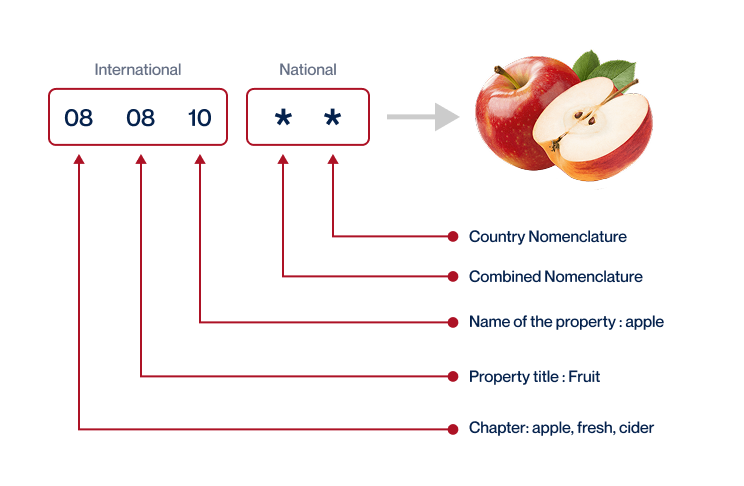
Step 3 – Calculate the Customs Value
Understanding ‘customs value‘ is essential when importing goods from Qatar to Bahrain. It isn’t merely the price you paid for the products. The customs value, or the CIF value, is determined by adding the cost of the goods, international shipping fees, and insurance costs. Let’s say you paid $1000 for goods, $200 for shipping, and $50 for insurance. Your CIF value, or customs value, would be $1250. It’s this number that’s used to calculate any import duties. Clear knowledge of these elements ensures no unexpected costs spring up later in your shipping process, keeping your bottom line intact. Remember, correctly calculating your customs value is not just about accurate payments; it is key to maintaining a smooth import process and avoiding potential legal complications.
Step 4 – Figure out the applicable Import Tariff
An import tariff is essentially a tax imposed on goods as they enter a country. They are used broadly, including in Bahrain, to control the flow of certain items and often to protect local industries from cheaper international competitors.
In Bahrain, the tariff system is broadly unified and follows the structure of the Harmonised System (HS). You must identify your product’s HS code to understand the applicable import tariff. Here’s how you do it:
1. Visit the National Bahrain Authority for Customs & Taxes website.
2. Navigate to the Trade Tariffs section.
3. Enter the HS code you’ve identified in the appropriate field.
4. Input the country of origin—Qatar.
Example: If you are importing machinery parts (HS code 8487.90.00) from Qatar into Bahrain, and the applicable tariff rate on the Bahrain customs website says 5%, you’ll need to calculate the import duties. Say the CIF (Cost, Insurance, and Freight) value of the product is $10,000. Then, the import duty will be 5% of $10,000, which is $500.
It’s always wise to cross-check these tariffs with your clearing or forwarding agent for accuracy and to keep abreast of any changes. Remember that customs duties can significantly affect your costs, so understanding them is critical to maintaining the competitivity of your imported goods.
Step 5 – Consider other Import Duties and Taxes
While the standard tariff rate is a significant cost component, there are other import duties and taxes you need to be aware of when shipping goods from Qatar to Bahrain.
For instance, depending on the product and its origin, you might face an excise duty which is often levied on certain goods like tobacco, or alcohol. Consider an example where your goods’ CIF value is $10,000, and the excise duty rate is 5%. Here, you will pay an extra $500 as excise duty.
Bahrain also implements anti-dumping taxes to protect its industries from unfairly priced imports. If an imported good falls under this category, an extra tax, usually ranging from 5-10%, may apply.
Another key financial component you should factor in is the Value Added Tax (VAT). In Bahrain, this is commonly set at 5% of the goods’ CIF value plus duty. So, if your CIF value is $10,000 and duty is $500, the VAT will be 5% of $10,500, which equals $525.
These examples give you a broad sense of potential costs, although exact rates could vary. Knowledge of these taxes and duties will help avoid unexpected costs and delays in the clearance process. Trust me, it’s worth considering them upfront!
Step 6 – Calculate the Customs Duties
In Step 6, you’ll be calculating your customs duties, effectively earmarking the amount payable on goods shipped from Qatar to Bahrain. This calculation mainly includes customs value, VAT, and other taxes, such as anti-dumping taxes. Let’s illustrate this with a few examples:
Example 1 (Customs Duties only): You’re importing wooden furniture valued at $10,000. With a 5% customs duty rate, you’ll pay $500 (5% of $10,000) in customs duties.
Example 2 (Customs Duties + VAT): Here, you’re importing electronic goods valued at $15,000. A 5% customs duty applies, followed by a 5% VAT on the total value plus customs duties. Your costs breakdown as: $750 in customs duties, then $787.50 in VAT (5% of $15,750), totalling $1,537.50.
Example 3 (Customs Duties, VAT, Anti-dumping taxes, and Excise Duty): You’re importing aluminium products valued at $20,000. A standard 5% customs duty applies. However, a 10% anti-dumping tax and a 5% excise duty are levied on top of this before charging the 5% VAT. Here, you’re looking at $1,000 customs duties, $2,000 anti-dumping taxes, $1,000 excise duty, then $2,050 for VAT (5% of $41,000), a total of $6,050.
To ensure you’re not overpaying, why not let DocShipper assist you? We handle every step of the customs clearance process anywhere in the world and offer free quotes in less than 24h! With DocShipper, you’re guaranteed precise and fair charges, every time.
Does DocShipper charge customs fees?
Navigating customs can be tricky, but DocShipper, as your custom broker in Qatar and Bahrain, keeps the whole process transparent and efficient. While we charge for customs clearance services, the actual customs duties and taxes go directly to the government – there’s no additional fees from our side. We’re committed to ensuring your business only pays what’s necessary and provide you with all the documentation from the customs office for full transparency. It’s like having a directing guide through the complexities of international freight, making the process smoother and easier for your business. So, breathe easy knowing we’ve got your back!
Contact Details for Customs Authorities
Qatar Customs
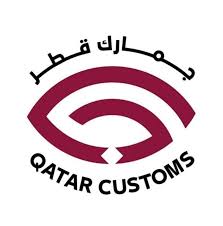
Official name: General Authority of Customs, Qatar Official website: https://www.customs.gov.qa/
Bahrain Customs
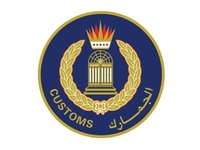
Official name: Customs Affairs of the Kingdom of Bahrain Official website: http://www.bahraincustoms.gov.bh
Required documents for customs clearance
Sorting through paperwork can feel daunting when shipping internationally. Here’s a brief guide to understanding and preparing key documents such as the Bill of Lading, Packing List, Certificate of Origin, and Documents of Conformity (CE standard) that are vital in getting your goods cleared by customs.
Bill of Lading
Navigating shipping between Qatar and Bahrain? Don’t underestimate the importance of the Bill of Lading (BOL). This official paper trail marks the transition of ownership from seller to buyer. Consider opting for an electronic (or ‘telex’) release to streamline the process – it’s a quicker, greener alternative to getting physical copies and can save you last-minute stress. For air cargo gurus, take note of the Air Waybill (AWB), equating to the BOL in air transport terms. Get it right, and customs clearance can be a breeze rather than a blockade. Remember, a well-prepped BOL or AWB is your ticket to smooth shipping! The key lies in understanding the power of these documents and using them to unlock easy international trade.
Packing List
When dealing with freight between Qatar and Bahrain, your Packing List is your indispensable guide – it’s like the roadmap for your shipment. Imagine being a pilot without a flight plan; that’s right, it’s untenable. Your responsibility is to create this document with extreme accuracy, as it details crucial information like item descriptions, quantities, and weights – all information that is essential for a smooth customs clearance process. And it doesn’t matter whether your goods ride the waves or soar through the sky; a Packing List is non-negotiable for both sea and air freight. For instance, a business shipping electronics would specify the number of laptops, monitors, or headphones in separate rows on the list. Any inaccuracies might lead to customs delays, ultimately stalling your business progress between these two thriving nations.
Commercial Invoice
Navigating the customs clearance between Qatar and Bahrain? Look keenly at your Commercial Invoice. This document, laden with essential details like product descriptions, shipment value, country of origin, and recipient details, is a key player in a seamless clearance process. For instance, if you’re shipping Electronics, your invoice should align with the HS code 85, just like other shipping documents. A mismatch? Expect roadblocks during clearance. Remember, the declared shipment value affects duties. Underestimating values may seem savvy until you’re caught—with severe penalties. So, provide accurate and consistent information. Aligning your Commercial Invoice effectively could turn potential hurdles into smooth sailing.
Certificate of Origin
Navigating customs between Qatar and Bahrain requires you to fully comprehend the necessity of a Certificate of Origin. This document is invaluable and certifies the country where your goods have been produced. For instance, you might be a Qatari business shipping handcrafted furniture made from locally-sourced timber to Bahrain. Your Certificate of Origin formally attests that your items are authentically Qatari, paving the way for smoother customs clearance.
But what’s the benefit to your bottom line? By detailing your goods’ origin, you could unlock preferential customs duty rates, directly impacting your costs and profit margins, offering substantial financial benefits. So, remembering this certificate isn’t just an administrative hoop – it’s a strategic move that could help your business thrive in the cross-border marketplace.
Get Started with DocShipper
Prohibited and Restricted items when importing into Bahrain
Navigating the maze of Bahrain’s customs regulations? Let’s dive straight in and demystify the rules. This section helps you avoid unpleasant surprises by simplifying and explaining the tricky world of prohibited and restricted goods in Bahrain. From regulations to potential penalties, we’ve got you covered!
Are there any trade agreements between Qatar and Bahrain?
Yes, there’s a Free Trade Agreement (FTA) between Qatar and Bahrain under the Gulf Cooperation Council (GCC). This FTA facilitates a smoother import/export process and potentially lower customs duties, simplifying your shipping process. Additionally, the GCC’s ongoing improvements to their road and sea connectivity further enhance the transport efficiency between these nations. Remember, while the FTA simplifies trade, it’s crucial to adhere to each country’s specific customs regulations. Stay updated and seize these advantageous trading conditions!
Qatar – Bahrain trade and economic relationship
Brimming with a rich history, Qatar and Bahrain’s economic relationship has evolved over time, making them key trade partners today. Their collaboration can be traced back to their shared history in the pearl industry, leading to extensive cooperation in sectors such as energy and aviation. Major commodities include natural gas, petroleum products, aluminum, and other goods, contributing to the trade volume 3 billions of dollars in 2023. Bahrain invests extensively in Qatar’s growing real estate, banking, and health sectors, while Qatari investments in Bahrain mainly target the manufacturing sector. Rich in tradition and progress, this partnership serves as a beacon in the Gulf Cooperation Council (GCC) trade relations.
Your first steps with DocShipper
Additional logistics services
Warehousing
Finding a trustworthy warehousing solution plays a crucial role in maintaining product quality—especially for items needing temperature control. Don't let storage worries burden you! We're here to handle it, providing expert solutions tailored to your goods. Want more depth? Jump in right here : Warehousing.
Packing
Ensuring your goods are safely packaged for the journey between Qatar and Bahrain is crucial, especially when you're shipping fragile or high-value items. From fashion apparel to heavy machinery, a reliable agent is key to repacking, protecting contents from potential harsh climatic conditions or rough handling. For instance, high-tech electronics require anti-static bubble wrap and sturdy cartons. Not all cargo is equal, and this is where our personalized packaging service truly shines.

Transport Insurance
Consider cargo insurance as your fail-safe against unforeseen mishaps during transport. Unlike fire insurance, which covers fire-specific loss, cargo insurance offers comprehensive protection for your goods en route, including from damage, theft, or loss. For instance, imagine your shipment facing a storm at sea or a road accident - this where cargo insurance steps in, mitigating these risks and providing peace of mind.
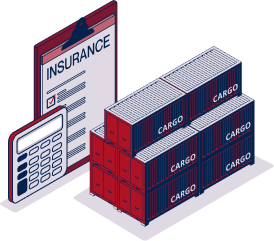
Household goods shipping
Shifting your valuable possessions between Qatar and Bahrain? Personal Effects Shipping ensures your delicate or outsized items travel securely and gently, adjusting to your unique needs. Imagine, that delicate vase or hefty antique chair arriving just as they were, sans stress and damage. This is moving made effortless, matching your pace and preferences.
Procurement in Thailand
When shipping from Qatar to Bahrain, finding reliable suppliers can be tricky. That's where DocShipper comes in. We bridge the language gap and handle all procurement steps, be it in Asia or East Europe. Imagine, no more misunderstandings in transactions or manufacturing blues. All this and more is taken care of by DocShipper. Dive deeper into our strategies on our dedicated page: Sourcing services.

Quality Control
Quality Control ensures your goods are crafted to perfection before shipping from Qatar to Bahrain. Picture this: You've commissioned exquisitely handcrafted furniture. A thorough inspection prevents that chair with an unstable leg from tarnishing your reputation. With us, you're safeguarding your standards and keeping your customers happy. Quality Control is like your personal sentinel between countries, guaranteeing only the best make the journey.

Conformité des produits aux normes
Understanding and adhering to product compliance regulations is key to hassle-free shipping. It can spell the difference between a smooth journey and costly, time-consuming delays. Our product compliance services come in, offering laboratory testing for your goods, ensuring they meet all necessary guidelines and obtain the proper certification for your destination country. This service saves you time and enhances efficiency, making your shipping experience smooth sailing.
